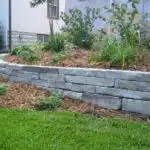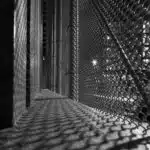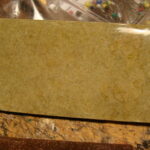Stone veneer is an excellent option for those who want to give their home or business a natural look without the cost and weight of traditional stone. Installing stone veneer can be a challenging project, but with the right tools and knowledge, it can be done efficiently and effectively. In this article, we will provide an overview of installing stone veneer, covering everything from preparation to finishing touches.
Before beginning any installation work, it is essential to prepare the area where the stone veneer will be applied. This involves cleaning the surface and ensuring that it is level and free from debris. Once this is done, you must begin preparing the mortar mix that will hold the stones in place. The next step is to apply a scratch coat on the surface, which acts as a base for the mortar mix. After this, you can begin applying the stone veneer pieces carefully. Finally, you must grout and seal everything correctly to ensure longevity and durability. With these steps in mind, let us dive into installing stone veneer in more detail.
Benefits Of Stone Veneer
Stone veneer is an excellent choice for both residential and commercial properties due to its durability advantages. One of the main benefits of stone veneer is that it can withstand harsh weather conditions such as extreme temperatures, wind, and rain without deteriorating. This makes it a long-lasting solution for those looking for a low-maintenance building material.
In addition to its durability advantages, stone veneer also offers aesthetic benefits. Stone veneer comes in a variety of colors and textures, making it easy to find the perfect fit for any design style. Whether you’re going for a traditional or modern look, there’s a stone veneer option available to suit your needs.
Overall, the benefits of stone veneer make it an attractive option for those looking to enhance their property’s appearance while also ensuring longevity. By choosing stone veneer, you’ll be investing in a material that not only looks great but also provides lasting protection against the elements. In the next section, we will explore the different types of stone veneer available on the market today.
Types Of Stone Veneer
As you begin your stone veneer installation project, one of the most important decisions you’ll make is choosing between manufactured and natural stone veneer. Manufactured stone is made from a composite material that mimics the look of natural stone, while natural stone is quarried directly from the earth. Both options have their pros and cons, so it’s important to consider factors like cost, durability, and aesthetics when making your decision.
When it comes to color selection, both manufactured and natural stone veneers offer a wide range of options. Natural stone offers unique variations in color and texture that can add character to your project, while manufactured stone often has a more uniform appearance. It’s important to choose a color that complements the style of your home or building and fits with the surrounding landscape.
To help narrow down your choices, here are four key factors to consider when selecting a type of stone veneer:
- Cost: Manufactured stone is generally less expensive than natural stone.
- Installation: Natural stone can be more difficult to install due to its weight and irregular shapes.
- Durability: Natural stone tends to be more durable over time than manufactured stone.
- Maintenance: Manufactured stone requires less maintenance than natural stone.
By taking these factors into consideration, you can choose the type of stone veneer that best meets your needs and budget for your installation project. In the next section we will explore the tools and materials needed for successful installation.
Tools And Materials Needed
After choosing the type of stone veneer that works best for your project, the next step is to gather all the necessary tools and materials. One crucial aspect of a successful installation is proper tool maintenance. Before starting, make sure all your tools are clean and in good working condition. Check for any signs of wear or damage, which can be dangerous and can affect the quality of your work.
When it comes to sourcing materials, it’s essential to plan ahead and ensure you have everything you need before starting. This includes purchasing enough stone veneer to cover your entire project area, as well as any necessary adhesives and mortar. It’s also important to consider factors like weather conditions and transportation logistics when ordering materials.
Proper tool maintenance and sourcing materials are crucial aspects of installing stone veneer successfully. By taking these steps seriously, you can ensure that your project will go smoothly from start to finish with minimal hiccups along the way. In the next section, we’ll discuss some important safety precautions to keep in mind during installation so that you can complete your project safely and efficiently.
Safety Precautions
Ensuring safety during a stone veneer installation job is crucial. The process requires working with heavy materials and tools that can be hazardous if not handled properly. Therefore, it is important to take precautions to protect yourself and others from potential accidents.
One of the most critical safety measures is wearing appropriate safety gear. This includes but is not limited to, gloves, goggles, hard hats, and work boots. Gloves protect your hands from cuts and bruises; goggles keep debris out of your eyes; hard hats prevent head injuries, while work boots provide protection for your feet. These items should be worn at all times during the installation process.
Another essential factor to consider when installing stone veneer is working conditions. Before beginning any task, ensure that the worksite is clean, organized, and free of obstacles. Cluttered workspaces can cause tripping hazards or make it difficult to move heavy equipment around safely. Always maintain a clear path for yourself and others working on the project.
Lastly, always follow the manufacturer’s instructions on how to use specific tools or equipment safely. Using tools improperly could lead to personal injury or damage to property. Proper handling of equipment will reduce the risk of accidents during installation.
- Always wear safety gear
- Keep the workspace clean and organized
- Maintain a clear path for yourself and others
- Follow manufacturer’s instructions on tool usage * Do not use equipment that is damaged or malfunctioning.
Preparing The Surface
Surface preparation is a crucial step in installing stone veneer. The surface must be clean, stable, and level to ensure the best outcome. Before starting the installation process, it is essential to inspect the surface area for any existing damage or decay that may need repair. Once you have assessed the condition of the surface, you can start with preparing it for the stone veneer.
Surface cleaning is an essential aspect of surface preparation. The surface must be free from dirt, dust, debris, and any other foreign materials that can affect the bonding of the stone veneer. You can use a power washer or a stiff bristle brush with water to remove all dirt and debris from the surface. Do not use chemicals on porous surfaces as it can cause discoloration and damage.
Preparation also involves ensuring that the surface is level and stable. Any unevenness in the wall or floor can result in an unattractive final product. It is necessary to fix any cracks, holes or uneven surfaces before proceeding with installation. Use a leveling compound to even out any bumps or dips on your wall’s surface if necessary. With proper preparation of your surface area, you are now ready for mixing mortar and beginning your installation process.
Mixing Mortar
After preparing the surface, it is now time to mix the mortar. The consistency of the mortar is crucial in ensuring a strong bond between the stone veneer and the surface. A good mortar mix should be able to hold its shape when squeezed and not slump or drip excessively.
To achieve the ideal consistency, you need to use the right mixing tools. A mixing paddle attachment for your drill is recommended as it saves time and ensures that all ingredients are well blended together. Alternatively, you can use a hoe or shovel to mix by hand. A wheelbarrow or large bucket can also be used as a mixing container.
When mixing, start with water and gradually add dry mortar mix until you reach your desired consistency. It’s important to follow manufacturer instructions on how much water to use per bag of mortar mix. Overmixing can cause air bubbles which weaken the bond between the veneer and surface while undermixing will result in poor adhesion. Once mixed, cover your mortar with plastic sheeting for at least 10 minutes before re-mixing again before application.
As soon as you have achieved the perfect mortar consistency, apply it onto your prepared surface using a trowel. This process is called “applying scratch coat” which serves as a base layer for stone veneer installation. The scratch coat should be about 1/4 inch thick and evenly distributed across the surface area where you plan to install your stone veneer. Let it cure for at least 24 hours before moving on to installing your chosen stone veneer pattern over it.
Applying Scratch Coat
An important step in the stone veneer installation process is applying the scratch coat. This is the first layer of mortar that will hold the veneer pieces in place. It’s crucial to ensure that this layer is applied correctly because it will determine the strength and durability of your installation.
Did you know that using improper trowel techniques can lead to a weak scratch coat? Using a notched trowel with the wrong size notches or overworking the mortar can create air pockets and prevent proper bonding between the scratch coat and veneer pieces. This can result in a weaker installation that may crack or even fall apart over time. To avoid this, it’s important to use the correct trowel and apply just enough pressure to spread the mortar evenly without creating air pockets.
After applying the scratch coat, it’s essential to allow sufficient curing time before proceeding with installing the veneer pieces. The curing time can vary depending on factors such as humidity and temperature, but typically takes one to three days. During this time, avoid touching or applying pressure on the surface as it may cause cracking or shifting of the mortar. Once fully cured, you can proceed with cutting and fitting veneer pieces for your final installation.
Cutting And Fitting Veneer Pieces
Cutting and fitting veneer pieces is a crucial step in the stone veneer installation process. It requires precision and patience to ensure that each piece fits perfectly on the surface of the wall. Proper cutting techniques must be employed to achieve a professional-looking finish.
One of the challenges in fitting veneer pieces is dealing with irregularities in the wall surface. This can be addressed by using a technique called “floating”. Floating involves applying a layer of mortar onto the wall surface, then pressing the veneer piece into it. This helps to even out any bumps or dips on the wall surface, ensuring that the veneer piece sits flush against it.
Another challenge when fitting veneer pieces is cutting them to size. A wet saw is typically used for this task, as it provides clean and precise cuts without damaging the material. However, if a wet saw is not available, other tools such as chisels or grinders can be used, although they may take longer and require more effort.
Moving onto installing corner pieces, there are several ways to approach this task depending on the type of corner being installed. In some cases, pre-made corner pieces can be used which eliminates much of the cutting and fitting required. Alternatively, custom-cutting corner pieces may be necessary for more complex corners. Either way, attention to detail and proper technique will ensure that corner pieces are installed seamlessly.
Installing Corner Pieces
Accurately measuring and cutting corner pieces of stone veneer is paramount to a successful installation. When cutting, it’s important to use a masonry blade to ensure clean cuts and minimize waste. Applying adhesive to the back of the stone veneer is necessary for a secure fit and long-lasting hold. Care should be taken to evenly spread the adhesive and ensure no air pockets are present.
Measuring And Cutting
As a stone veneer installation expert, it is important to emphasize the significance of precision when measuring and cutting corner pieces. Cutting techniques play a crucial role in ensuring that the pieces fit and align perfectly, creating seamless joints that enhance the overall aesthetics of the project. To achieve this, one must use specialized measuring tools designed for stone veneer installation such as T-squares, straight edges, and tape measures.
Incorporating cutting techniques into your approach is also vital when installing corner pieces. One must have a good understanding of the different types of cuts needed to create angles that fit snugly together. This requires an eye for detail and finesse in using tools such as chisels, saws, and grinders. Properly executing these cuts will allow for a tight fit between each piece and prevent any gaps from forming between the stones.
Ultimately, measuring and cutting corner pieces is a critical step in achieving a flawless stone veneer installation. It requires a combination of skillful cutting techniques and precise measurements using specialized tools. By taking the time to perfect these skills, one can create beautiful masonry work that will stand the test of time without needing costly repairs or replacements down the road.
Applying Adhesive
Applying adhesive is the next crucial step in installing corner pieces for a stone veneer project. This process involves selecting the correct bonding technique and ensuring that the adhesive is applied evenly across all surfaces. The type of adhesive used will depend on the specific project requirements, but it is essential to choose one with strong bonding properties that can withstand environmental factors such as moisture and temperature changes.
To properly apply adhesive, one must begin by cleaning and preparing the surface of each stone. This ensures that there are no contaminants or debris that could interfere with the bonding process. Next, the adhesive should be spread evenly across the back of each stone using a notched trowel. It is important to avoid leaving any air pockets or gaps between stones as this can weaken the overall structure of the installation.
Finally, once all corner pieces have been fitted and bonded together, it is important to allow sufficient time for curing before applying any sealant or grout. This will ensure that the adhesive has fully cured and achieved maximum strength, providing long-lasting durability for your stone veneer project. By following these steps carefully and using proper bonding techniques, one can achieve a flawless installation that enhances both functionality and aesthetics while standing strong over time.
Grouting The Joints
Before grouting the joints, it is important to take a moment to appreciate the beauty of your newly installed stone veneer. The natural textures and colors of the stones create an organic aesthetic that adds character and value to any home. However, without proper grouting techniques, your installation may not look as polished or professional as you desire.
Grouting is the process of filling in the spaces between the stones with a cement-based material. This not only helps secure the stones in place but also provides a finished look to the installation. When choosing a grout color, select one that complements or contrasts with your stone veneer. Popular options include gray, beige, and brown tones.
To begin grouting, mix your preferred color option according to manufacturer instructions and apply it using a rubber float or trowel. Press it firmly into each joint while making sure there are no air pockets or gaps left behind. After allowing sufficient drying time, usually 24-48 hours depending on temperature and humidity levels, use a damp sponge or cloth to wipe away any excess grout on the surface of the stones.
With successful completion of grouting techniques, your stone veneer installation will have an enhanced visual appeal that will last for years to come. However, before moving onto sealing the veneer for added protection against weather and wear-and-tear damage, ensure that all joints are filled evenly with no visible holes or cracks.
Sealing The Veneer
After grouting the joints, it is time to move on to sealing the veneer. Sealing your stone veneer has many benefits, such as protecting it from water damage and staining. It also helps to preserve the natural color of your stone for a longer period of time. However, before applying any sealant, there are some precautions that need to be taken.
Firstly, ensure that your stone veneer is completely dry before applying any sealant. This will prevent moisture from being trapped underneath the sealer and causing damage over time. Additionally, make sure that the temperature is above 50°F during application and for at least 24 hours after. Applying sealant in cold temperatures can cause it to not cure properly.
When it comes to techniques and products for sealing your stone veneer, there are a few options available. One common technique involves using a sprayer or roller to apply the sealer evenly across the surface of your stones. You may also consider using a penetrating sealer which will soak into the pores of your stone rather than just sitting on top of it. As for products, there are many different brands and types of sealers available on the market today, so be sure to choose one that is specifically designed for use with natural stone veneers.
Moving on to cleaning and maintenance, it is important to note that regular upkeep will help prolong the life of your stone veneer installation. Some general tips include avoiding harsh chemicals when cleaning your stones and using a soft-bristled brush or sponge instead of abrasive materials like steel wool or metal brushes. Additionally, be sure to inspect your stones periodically for any signs of damage or wear and tear so that you can address any issues before they become major problems.
Cleaning And Maintenance
Maintaining and cleaning your stone veneer is crucial to ensure its long term durability. Properly maintaining your stone veneer will help prevent discoloration, mold growth, and damage. Choosing cleaners suitable for your particular type of stone veneer is important since certain cleaners may contain chemicals that can deteriorate or discolor the material.
When selecting cleaners for your stone veneer, it is essential to read the label carefully and consider the instructions provided by the manufacturer. It is recommended to use a mild cleaner with a neutral pH level, such as water and a soft-bristled brush. Avoid using abrasive products or high-pressure washers as they can cause damage to the surface of the stone. Additionally, it is important to avoid using acidic cleaners, which can lead to chemical reactions that may harm the surface.
Long term durability of your stone veneer depends on regular maintenance and proper cleaning techniques. Despite its natural resilience, wear and tear can still occur over time. In order to ensure that your stone veneer remains in top condition for years to come, it is recommended that you clean it at least once every six months. This will not only keep it looking great but also help prevent any further damage from occurring.
To maintain their homes’ beauty and functionality, many homeowners opt for DIY projects rather than hiring professionals. However, when it comes to installing or repairing stone veneers, this may not be the best option. While DIY projects save money upfront, they often result in higher costs down the road due to mistakes made during installation or repair. In our next section, we discuss whether DIY or hiring professionals is better when installing stone veneers.
Diy Vs. Hiring A Professional
After ensuring that your stone veneer is properly cleaned and maintained, the next step is to decide whether to undertake the installation yourself or hire a professional contractor. DIY installations can be an attractive option for homeowners looking to save money on labor costs, but they come with their own set of challenges. For instance, inexperienced installers may struggle with the precision and attention to detail required for successful stone veneer installation. Additionally, DIY projects may take longer than anticipated, leading to frustration and increased expenses.
On the other hand, finding reliable contractors can also present its own set of challenges. Homeowners must do their due diligence in researching potential contractors and checking references before hiring them for any project. They should also obtain multiple quotes from different contractors to ensure that they are getting a fair price. Some contractors may try to cut corners or use subpar materials in order to increase their profit margins, so it is important for homeowners to educate themselves on what constitutes quality workmanship.
When deciding between DIY installation and hiring a contractor, it ultimately comes down to personal preference and skill level. While some homeowners may feel confident in their ability to tackle the project themselves, others may prefer the peace of mind that comes with hiring a professional. Regardless of which route you choose, it is important to carefully weigh all factors before making a decision.
Moving forward into cost considerations, it is important for homeowners to understand the various expenses associated with stone veneer installation. From materials and labor costs to permits and inspections, there are many factors that can impact the overall price tag of your project. By taking these considerations into account early on in the planning process, you can ensure that you stay within budget while still achieving your desired outcome.
Cost Considerations
- Calculating the cost of a stone veneer installation requires consideration of multiple factors, including labor costs, materials costs and any additional services or items needed.
- Labor costs can vary significantly depending on the size and complexity of the project and the individual contractor’s rates.
- Material costs are determined by the type of stone chosen and the necessary installation supplies and tools.
- When estimating the cost of a stone veneer installation, the total square footage of the area to be covered should be taken into account.
- To accurately determine the cost of the project, any additional services or items needed, such as mortar or grout, should also be factored in.
- It is important to get accurate and up-to-date pricing information from reliable sources to ensure the most accurate cost estimates for a stone veneer installation.
Cost Calculations
When considering the cost of installing stone veneer, several factors must be taken into account. One of the most significant considerations is the installation timeline. Stone veneer installation is a complex process that requires careful planning, precise execution, and attention to detail. Depending on the size and complexity of the project, it can take anywhere from a few days to several weeks to complete.
Another critical factor to consider when calculating the cost of installing stone veneer is labor costs. The amount of labor required for a project will depend on several factors, including the size and complexity of the job and the experience level of the installer. Labor costs can vary widely depending on these factors, so it’s important to get a detailed estimate before beginning any work.
While there are many other cost considerations when installing stone veneer, these two factors are among the most significant. By carefully planning your project timeline and understanding how labor costs will affect your budget, you can ensure that you’re getting a fair price for your stone veneer installation while still achieving stunning results.
Labor Costs
When it comes to installing stone veneer, considering the cost is a crucial step in ensuring that the project stays within budget. One of the most significant factors that affect the overall cost is labor costs. The amount of labor required for a project depends on several factors, including the size and complexity of the job and the experience level of the installer. Therefore, estimating labor costs accurately is essential to avoid any surprises or hidden fees.
Factors affecting labor costs include the type of stone veneer being used, equipment required, and necessary preparations before installation. For instance, if the chosen stone veneer requires extensive cutting or shaping to fit specific areas, it can increase labor costs significantly. Similarly, if specialized equipment is needed for installation or preparation work such as scaffolding or heavy machinery, it can add to overall expenses.
To estimate labor costs accurately, it’s essential to get a detailed estimate from an experienced installer before beginning any work. A reputable installer will take into account all relevant factors and provide an accurate quote that includes all aspects of installation labor. It’s also vital to note that while labor costs are an important consideration when installing stone veneer, choosing inexperienced installers to save money could lead to costly mistakes down the line. Therefore, investing in skilled professionals ensures quality work that lasts for years while staying within budget.
Materials Costs
Stone veneer installation is a great way to enhance the look of any property. However, it is essential to consider the cost of installation before starting any work. One critical factor that affects the overall cost is materials costs. The type and quality of stone veneer being used play a significant role in determining the price. In general, natural stone veneers are more expensive than manufactured stone veneers due to their superior quality and durability.
When budgeting for stone veneer installation, it’s crucial to keep materials costs in mind. Typically, the price of stone veneer varies depending on factors such as color, size, and style. Additionally, other materials such as mortar or adhesive may also be required for installation and can add up quickly. To avoid overspending on materials, it’s advisable to get a detailed estimate from an experienced installer who can help determine the appropriate quantities needed while keeping budget constraints in mind.
In conclusion, when it comes to installing stone veneer, considering material costs is just as important as labor costs. Proper budgeting tips include researching different types of stone veneers available and consulting with a professional installer who can provide an accurate estimate based on your specific project needs. By carefully planning and budgeting for materials costs upfront, you can ensure that your project stays within budget without sacrificing quality or aesthetics.
Final Thoughts And Tips
As a stone veneer installation expert, I implore you to recognize the DIY challenges that come with this project. It may seem simple, but it requires diligence and precision. Taking shortcuts might lead to costly mistakes that could have been avoided. Therefore, take your time and follow the instructions carefully.
Another important aspect of installing stone veneer is finding inspiration. Before starting, browse through design magazines or home improvement websites to get an idea of what you want your final product to look like. This will help you choose the right type of stone and color palette for your project. Additionally, it’s crucial to select a pattern that complements your home’s exterior aesthetic.
In summary, installing stone veneer can be a fulfilling DIY project if done correctly. However, it comes with its challenges and requires patience and attention to detail. Remember to find inspiration before starting and choose a pattern that complements your home’s exterior aesthetic. With these tips in mind, you’ll be able to create a stunning stone veneer installation that will enhance the beauty of your home for years to come.
Conclusion
Stone veneer installation is an excellent way to add aesthetic value and durability to the interior and exterior of your home. The benefits of stone veneer include its ability to enhance the overall appearance of your property, its low maintenance requirements, and its long-lasting quality. However, before embarking on this project, it is essential to understand the various types of stone veneers available in the market, such as natural stone or manufactured stone.
When installing stone veneer, you will require a variety of tools and materials, including safety equipment such as gloves and goggles. Preparing the surface for installation is also critical; this involves cleaning the area thoroughly and ensuring that it is level. It is important to note that while DIY installation may seem like a cost-effective option, hiring a professional may be more practical in terms of ensuring accuracy and minimizing mistakes.
In conclusion, installing stone veneer can transform your property into an elegant masterpiece while providing additional protection from external elements. It is important to consider both DIY and professional options when weighing cost versus benefit. Remember that investing in high-quality materials and enlisting professional help can save you time, money, and frustration in the long run. With proper preparation, installation techniques, cleaning methods, and maintenance practices, your new stone veneer will last for years to come – a testament to your excellent taste in home design!
Image Credits
- “www.ilkkajukarainen.fi” by www.ilkkajukarainen.fi (featured)




![Calculating How Much Stone Dust You Need 4 [Blog Post]Stone Dust © Oxfam Australia](https://green-life.blog/wp-content/uploads/2023/05/GdZVzgTqPhjq-150x150.jpg.webp)
























